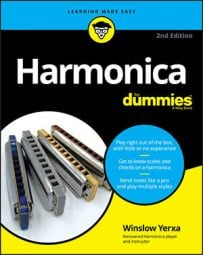Whether playing clean or distorted, some harmonica players usually favor small speakers — either 8 or 10 inches in diameter — that are configured in pairs or in fours. Why? The harmonica is a high-pitched instrument, and smaller speakers deliver high-pitched sound most efficiently. They also respond rapidly — they bark, as harmonica players like to say. Other players get along just fine with speakers as large as 15 inches.
To find what works for you, experiment and listen to the results.
For clean amplified playing, look for an amplifier made for acoustic guitar or keyboards. Often these amplifiers have a much higher power output than an electric guitar amplifier (200 to 400 watts versus 20 to 100 watts), giving them the ability to deliver clean sound without distortion — even at high volume.
Because acoustic instruments use microphones just as harmonicas do, acoustic instrument amps have inputs that are specially designed for mics, and they may have better feedback rejection than electric guitar amps.
To play distorted, harmonica players often use electric guitar amplifiers that have been adjusted and modified to work with harmonica. Guitar amps tend to emphasize high frequencies and bright sound, which sound great with guitar but harsh with harmonica. The high power gain in the preamp stage can cause a microphone to produce feedback at low volumes. To deal with these problems, harmonica players
Adjust the tone controls. To do so, you turn off the bright button, turn the treble way down, turn the bass way up, and adjust the middle to taste.
Turn down the preamp stage. This can only be done if this stage has a control.
Swap the tubes, which are internal plug-in parts that look like tiny science-fiction light bulbs. Substituting one type of tube for another can reduce treble frequencies, lower the preamp gain, and make the amp distort more easily.
Don’t attempt to swap tubes unless you know what you’re doing and you understand how to avoid death and injury from electric shock.
If you value your hearing more than loudness for its own sake, you can experiment with the following ways to achieve distortion without blasting the world out of existence:
Play through a small amp. A small, low-powered amp can give you distortion without ear-splitting volume. If the small amp isn’t loud enough for the band or the room, put a mic in front of the amp and feed the sound through the house sound system.
Use a distortion effect or preamp. Distortion effects units that work with any amp are available, and you can usually adjust the distortion to suit your desired sound.
Explore amp modelers. An amp modeler is a book-sized unit that models the characteristic sound of several different effects units, preamps, amps, and even speakers. You can create and save your favorite settings and switch among them at will. Why lug around a huge amp and tons of effects units when you can just toss an amp modeler in your bag along with your harps and a mic?

